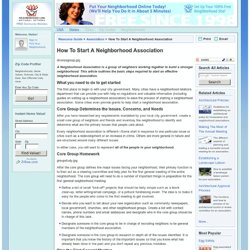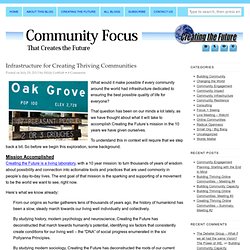

How To Start A Neighborhood Association. A Neighborhood Association is a group of neighbors working together to build a stronger neighborhood.

This article outlines the basic steps required to start an effective neighborhood association. What you need to do to get started The first place to begin is with your city government. Many cities have a neighborhood relations department that can provide you with help on regulations and valuable information (including guides on setting up a neighborhood association) to ease the process of starting a neighborhood association. Some cities even provide grants to help start a neighborhood association. Core Group Determines the Issues, Concerns, and Needs After you have researched any requirements mandated by your local city government, create a small core group of neighbors and friends and inventory the neighborhood to identify and determine what are the primary issues that people care about.
In either case, you will want to represent all of the people in your neighborhood . Core Group Homework. Partners for Livable Communities. Support for Communities to Grow Strong - Inspiring Communities. A Tour of Ethelo « PublicForums. Facilitators, decision makers, stakeholders… Do you need: Better ways for your community to make decisions? More empowering ways for participants to express their opinions? A reliable tool for parsing the data you get from public consultations? Better, faster and more meaningful results? Ethelo seamlessly weaves the power of in-person dialogue and deliberation with an unprecedented software solution for online decision making in a social network to provide a clear path forward.
The magic happens when Ethelo takes a myriad of possible outcomes and ranks them according to the outcomes that have the greatest stakeholder support with the least inequality of satisfaction. Overcoming conflict to find common ground All too often contentious issues polarize communities, governments and organizations. Finding solutions in direct stakeholder feedback Balancing polarized groups If we graph the satisfaction of a traditional majority-rules vote, it might look something like this. How it works. Home - Abundant Community. How to Make Better Decisions Together. Learning how to make decisions together is a crucial element of getting along and getting things done with others.

It’s wise for your group to learn how to steer your boat together with collective decision-making before you have a sinking ship on your hands. I’ve learned these skills through workshops, readings and from living and working in cooperatives and they have been incredibly valuable to the success of these projects.
Collective decision-making has innumerable rewards. If group members affected by the decision are involved, less conflict will result. If folks implementing the decision are involved, decisions are more likely to be implemented with hard work and enthusiasm, and empowered decision-makers are likely to stick around for the long haul. A strong example of collective decision-making is participatory budgeting which often leads to less contentious, more inclusive budgetary decisions – not an easy challenge.
Consensus flowchart by Grant Horwood Group Mind Facilitation. Organize. Orgs resources. Metamotivation.
Social capital. Asset Based Community Development. Social Resource Mapping. Transition Town Movement. Community Support Groups and Local Action. Clay Shirky: Institutions vs. collaboration. Commons. Open Source Ecology. Infrastructure for Creating Thriving Communities. What would it make possible if every community around the world had infrastructure dedicated to ensuring the best possible quality of life for everyone?

That question has been on our minds a lot lately, as we have thought about what it will take to accomplish Creating the Future’s mission in the 10 years we have given ourselves. To understand this in context will require that we step back a bit. So before we begin this exploration, some background. Mission AccomplishedCreating the Future is a living laboratory, with a 10 year mission: to turn thousands of years of wisdom about possibility and connection into actionable tools and practices that are used commonly in people’s day-to-day lives. The end goal of that mission is the sparking and supporting of a movement to be the world we want to see, right now. Here’s what we know already: By studying modern sociology, Creating the Future has deconstructed the roots of our current cultural norms – the workplace.
His answer: The electric utility. A new way of living is not only possible, it is happening now! Sustainable Villages/ Resilient Communities. Resilience.org.